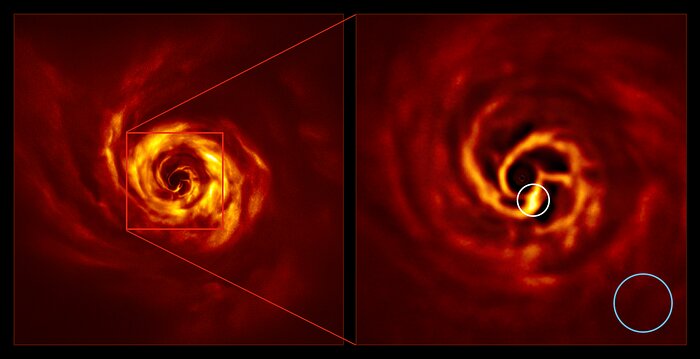|
|
Post by jandl100 on Apr 7, 2020 17:15:59 GMT
Remember those free-wheeling exoplanets careening through space on their ownsome, not orbiting a star? Bloody cold, you might expect, too cold for life. But maybe high levels of geological radioactivity could make otherwise frozen planets habitable. A planet can maintain water and other liquids on its surface if it’s heated, not by starlight, but by radioactive decay, researchers calculate. That opens up the possibility for many planets previously considered too cold — even free-floating worlds untethered to stars — to host life, they speculate. Researchers have now proposed that some planets, particularly ones that form near the center of our Milky Way Galaxy, might possess enough of these radioactive isotopes to generate sufficient heat to keep their surfaces from freezing entirely solid. www.sciencemag.org/news/2020/04/no-star-no-problem-radioactivity-could-make-otherwise-frozen-planets-habitable |
|
|
|
Post by MartinT on Apr 7, 2020 17:42:44 GMT
How can life form in such a radioactive environment?
|
|
|
|
Post by jandl100 on Apr 7, 2020 18:22:10 GMT
The linked article mentioned one Earth species who would apparently lap it up. Life on Earth can thrive in an amazing diversity of habitats. en.wikipedia.org/wiki/ExtremophileFormation, well, I suspect we don't understand much about that at all atm. en.wikipedia.org/wiki/LifeI guess it might evolve through mutation quite quickly! So I suspect we might be quite surprised at the complexity that might result. |
|
|
|
Post by jandl100 on May 21, 2020 4:26:18 GMT
Scientists may have caught the first-ever pictures of a planet being born around a young star, using the European Southern Observatory’s Very Large Telescope (ESO’s VLT). The stunning images show swirls of dust and gas spiraling around the star system AB Aurigae, about 520 light-years, from Earth and the “twist,” where astronomers suspect a planet is forming. According to an ESO statement, the research is likely the first direct evidence of a baby planet being born. In this image the very much brighter central star is blanked out so as to allow the gas and proto-planet to be seen.  futurism.com/stunning-images-planet-being-born?mc_cid=24a7cea94e&mc_eid=092f9d027b futurism.com/stunning-images-planet-being-born?mc_cid=24a7cea94e&mc_eid=092f9d027b |
|
|
|
Post by MartinT on May 21, 2020 7:11:19 GMT
Fab!
|
|
|
|
Post by jandl100 on May 23, 2020 8:30:18 GMT
There is a bold plan to take a picture of an Earth-like planet around another star that was sharp enough to see continents, oceans, and clouds. One problem is that you'd need a 90-kilometer-wide conventional telescope to see surface features on a planet 100 light years away. But what if we could use our own Sun as a gravitational lens to focus in on relatively nearby exoplanets? - we'd capture an image of an exoplanet so sharp that we can see features just 10 kilometers across. But that would entail placing a small telescope at the focal point for a specific exoplanet - For an exoplanet 100 light years away, the focal point is 97 billion kilometers (60 billion miles) away—16 times further from the Sun than Pluto. Voyager 1, which has ventured further into space than any other human-made object, has only traveled about 20 billion kilometers (13 billion miles), and it took the spacecraft 40 years to get there. The solution to getting there faster? Solar sailing. Solar sails capture the momentum of light from the Sun and use that momentum as propulsion. Using this technology, a small spacecraft would fly close to the Sun, pick up speed and fling itself toward the outer reaches of our solar system, making the journey in just 25 years. NASA believes in the concept enough to have recently awarded it a $2 million grant from its NIAC (NASA Innovative Advanced Concepts) program. Not that I'll be around to see the results if the project went ahead - fascinating stuff, though. phys.org/news/2020-05-bold-continents-oceans-earth.html?utm_source=nwletter&utm_medium=email&utm_campaign=daily-nwletter |
|
|
|
Post by MartinT on May 23, 2020 9:38:24 GMT
The time delay in controlling such a distant vehicle will be challenging.
I have no chance of being around in 25 years either!
|
|
|
|
Post by jandl100 on May 23, 2020 10:05:49 GMT
Yes, it would have to be largely autonomous.
And the position would only be right for one exoplanetary system, so you'd need a fleet of them scattered around the outskirts of the system to see more.
30 years, say, for planning and execution - I'd be 94. Hmm, doubtful.
I bet they'd have figured out better ways to do it before then, anyway.
Mind you, that 25 years was for an exoplanet 100 light years away, the focal point would be much nearer for closer stars, I should think - there's an exoplanet around Proxima Centauri, only 4 light years away. I bet you could get a gravitational lens telescope set up a lot sooner for that.
|
|